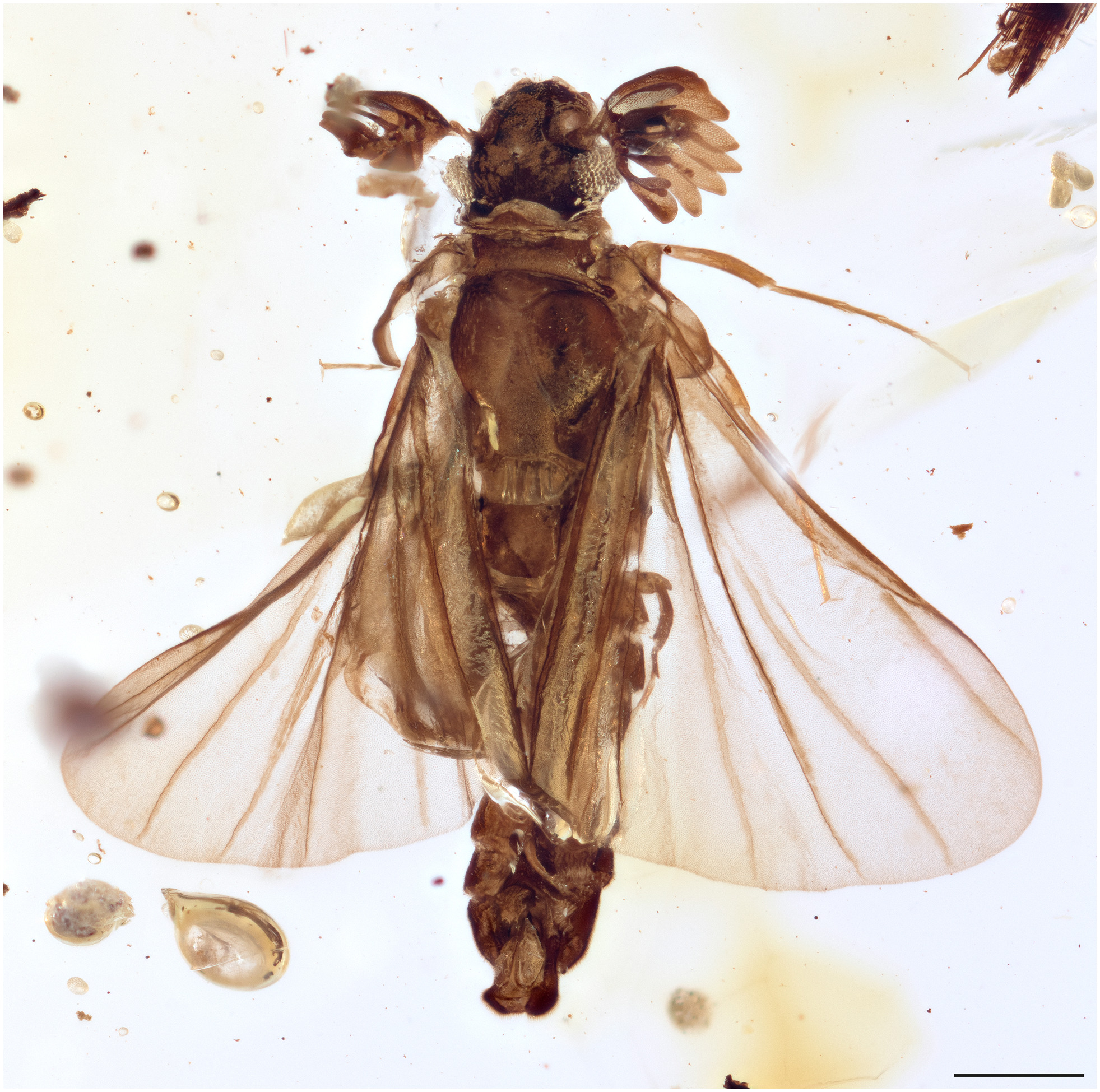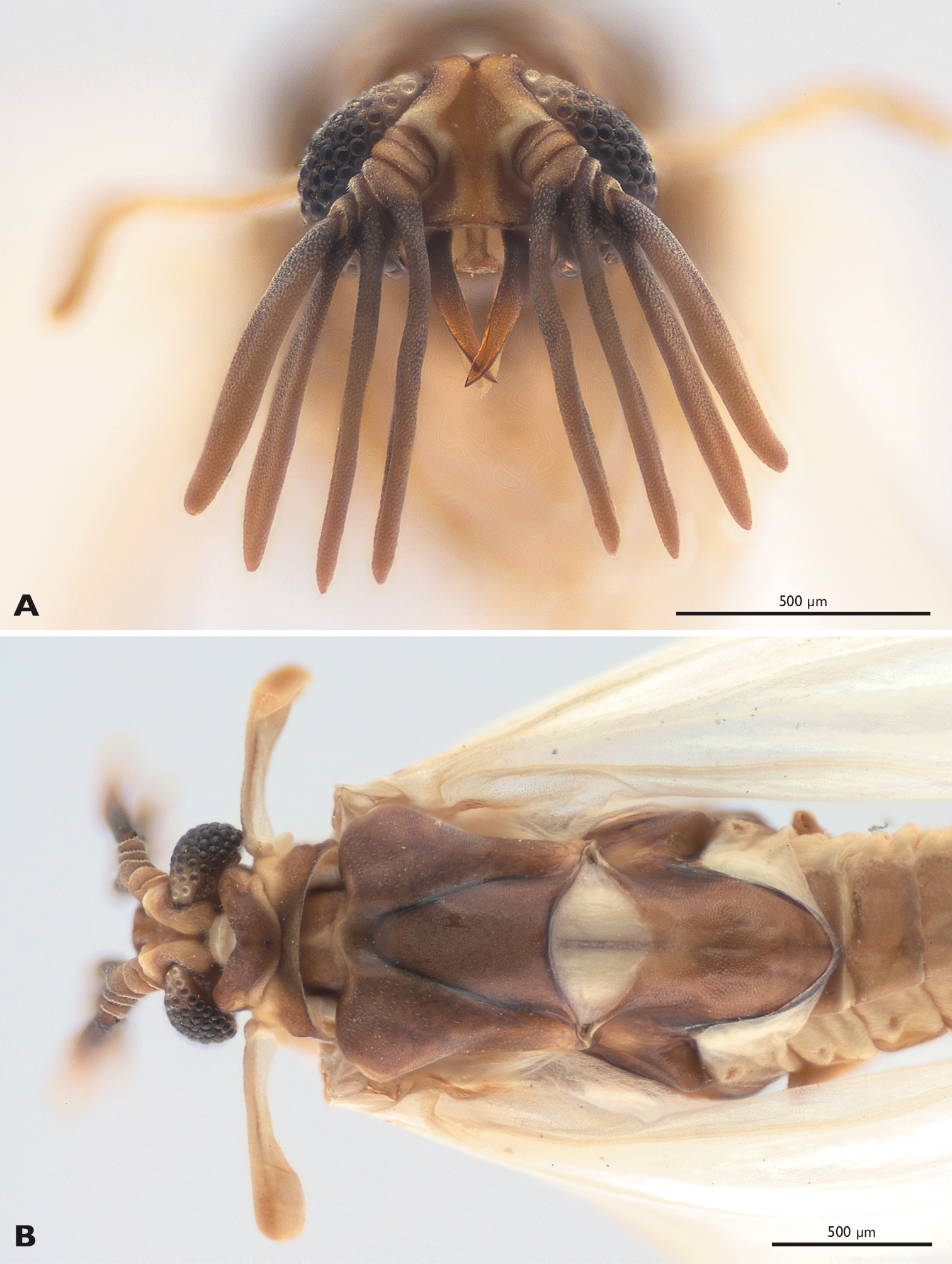부채벌레목
"오늘의AI위키"의 AI를 통해 더욱 풍부하고 폭넓은 지식 경험을 누리세요.
1. 개요
부채벌레목은 꼬인 날개(Strepsiptera)를 의미하며, 곤충의 일종으로, 수컷은 날개, 다리, 겹눈, 촉각을 갖지만 구기는 퇴화되어 먹이를 섭취할 수 없고, 암컷은 대부분 숙주에 기생하며 날개, 다리, 눈이 퇴화된 유약생식 형태를 띤다. 부채벌레목은 다양한 곤충에 기생하며, 암컷은 숙주의 몸 안에서 알을 낳고 유충은 새로운 숙주를 찾아 기생한다. 부채벌레목은 딱정벌레목의 자매군으로 분류되며, 해충 방제에 잠재적인 가치를 가질 수 있다.
더 읽어볼만한 페이지
| 부채벌레목 - [생물]에 관한 문서 | |
|---|---|
| 기본 정보 | |
 | |
 | |
| 학문적 분류 | |
| 학명 | Strepsiptera |
| 명명자 | Kirby, 1813 |
| 하위 분류군 순위 | 과 (Families) |
| 하위 분류군 | †Protoxenidae †Cretostylopidae †Phthanoxenidae †Mengeidae Bahiaxenidae Mengenillidae 스타일로피디아 (Stylopidia) Bohartillidae Callipharixenidae Corioxenidae Elenchidae †Protelencholacidae Halictophagidae Myrmecolacidae Xenidae Stylopidae |
| 일반 정보 | |
| 과 | 곤충강 |
| 아강 | 유시아강 |
| 하강 | 신시하강 |
| 상목 | 내시상목 |
| 목 | 부채벌레목 (Strepsiptera) |
| 학명의 명명자 | Kirby, 1813 |
2. 생태
부채벌레목 곤충들은 좀목(좀벌레 및 근연종), 메뚜기목(메뚜기, 귀뚜라미), 바퀴목(바퀴벌레), 사마귀목(사마귀), 노린재목(노린재), 벌목(말벌, 개미 및 꿀벌), 파리목(파리) 등 다양한 곤충에 기생한다.[1] Myrmecolacidae과의 수컷은 개미에, 암컷은 메뚜기목 곤충에 기생하며,[1] Mengenillidae과는 좀목만을, [18] Stylopidia는 날개가 있는 곤충만을, Stylopidae과는 꿀벌만을 공격한다.[7]
암컷은 수컷을 유인하는 페로몬을 분비하며,[1] 일부 종은 여러 수컷과 짝짓기를 한다.[11] 짝짓기는 외상적 수정 방식으로 이루어지는데, 이는 빈대와 같은 다른 곤충에서도 나타나는 현상이다.[1][11]
알은 암컷 몸 안에서 부화하며, 부화한 플라니디움 유충은 암컷의 혈강 안에서 자유롭게 움직이며 어미를 섭취한다(혈체강 태생).[12] 암컷은 수천 마리의 유충을 생산하며,[13] 유충들은 암컷 머리의 배출구를 통해 숙주 밖으로 나온다.[12][13]
1령 유충은 다리가 있어 새로운 숙주를 찾는다. 이들의 다리는 부분적으로 퇴화되어 돌기가 없다.[13] 유충은 제한된 시간 안에 숙주를 찾아야 하므로 매우 활동적이며, 눈점을 가지고 있다. 숙주에 달라붙은 유충은 효소를 분비하여 숙주의 큐티클을 부드럽게 하고 몸 안으로 들어간다. 파푸아뉴기니의 ''Stichotrema dallatorreanurn'' Hofeneder 유충은 메뚜기목 숙주의 발로 들어간다.[14]
숙주 안으로 들어간 유충은 과변태를 거쳐 다리가 없는 유충 형태로 변태한다. 이들은 숙주에게 주머니 모양의 구조를 만들도록 유도하여 그 안에서 먹고 자라며, 숙주의 면역 방어로부터 보호받는다. 유충은 4번의 령을 더 거치며, 탈피 시 낡은 큐티클은 버려지지 않아 유충 주위에 여러 겹의 층을 형성한다.[15] 수컷 유충은 마지막 탈피 후 번데기가 되지만, 암컷은 유생 성체가 된다.[16][17] 기생당한 숙주는 불임이 되거나 행동 변화를 겪을 수 있다. 성체 수컷은 숙주 몸에서 나오지만, 암컷은 안에 머물며, 암컷은 숙주 복부 부피의 최대 90%를 차지할 수 있다.[1] 성체 수컷의 수명은 대개 5시간 미만이며 먹이를 먹지 않는다.[1]
드물게 여러 암컷이 하나의 숙주에 기생할 수 있으며, 여러 수컷이 하나의 숙주에 기생하는 경우는 더 흔하다.[1] Myrmecolacidae과는 숙주의 행동에 영향을 미칠 수 있는데, 개미 숙주가 풀잎 끝에 머물도록 하여 부채벌레목 수컷에게 발견될 가능성을 높인다.[19]
2. 1. 형태
수컷 부채벌레는 날개, 다리, 겹눈, 더듬이를 가지지만, 입은 먹이를 먹는 데 사용되지 않고 대부분 감각 기관으로 변화했다. 겉모습은 파리와 유사하다.[1] 앞날개는 평형곤이라는 작고 곤봉 모양의 구조로 변형되었고[5], 뒷날개는 부채 모양이며 날개맥은 크게 퇴화하였다. 더듬이는 부채 모양(편상)이며, 멀리서도 암컷의 존재를 감지할 수 있는 특수한 화학 수용체로 덮여 있다.[7] 성체 수컷의 눈은 삼엽충 그룹 파코피나에서 발견되는 눈과 유사하며, 수십 개의 "눈구멍"으로 구성되어 각각 완전한 이미지를 생성한다. 이러한 눈구멍들은 큐티클 및/또는 강모로 분리되어 전체적으로 눈이 딸기 모양을 띤다.[1][8]대부분의 암컷 부채벌레는 숙주를 떠나지 않고 유생 형태를 유지하며, 날개, 다리, 눈이 없다. 머리가슴은 경화되어 있다.[32][38][36] 예외적으로, Mengenillidaela과와 Bahiaxenidaela과의 암컷은 자유 생활을 하며 다리와 작은 눈을 가지고 있어 어느 정도 이동이 가능하다.[39][38][36]
갓 부화한 1령 유충은 평균 230μm 크기로 매우 작아, 일반적인 단세포 생물과 비교해도 작다. 잘 발달된 홑눈으로 이동이 가능하며, 색을 식별할 수 있다. 몸의 하부는 미세한 털과 같은 구조로 덮여 있으며, 모세관 현상을 이용하여 젖은 표면에 달라붙을 수 있다. 몸 뒤쪽에는 잘 발달한 강모와 같은 구조의 꼬리뿔이 있는데, 이 꼬리뿔은 근육과 연결되어 있어 도약이 가능하다. 족절의 구조로 숙주에 붙을 수 있으며, 일단 숙주에 기생한 노령 유충은 그 자리에서 움직이지 않는다.[36]
2. 1. 1. 수컷
수컷 부채벌레는 날개, 다리, 겹눈, 더듬이를 가지지만, 입은 먹이를 먹는 데 사용되지 않고 대부분 감각 기관으로 변화했다. 겉모습은 파리와 유사하다.[1] 앞날개는 평형곤이라는 작고 곤봉 모양의 구조로 변형되어 자이로스코프 정보를 감지한다.[5] 파리도 비슷한 기관을 가지고 있지만, 파리는 뒷날개가 변형되었으며, 두 그룹은 이 구조를 독립적으로 진화시킨 것으로 보인다.[6] 뒷날개는 부채 모양이며, 날개맥은 크게 퇴화하였다. 더듬이는 부채 모양(편상)이며, 멀리서도 암컷의 존재를 감지할 수 있는 특수한 화학 수용체로 덮여 있다.[7]성체 수컷 부채벌레의 눈은 다른 어떤 곤충의 눈과도 다르다. 삼엽충 그룹 파코피나에서 발견되는 눈과 유사하며, 수백에서 수천 개의 겹눈으로 구성되어 전체 이미지의 화소를 각각 생성하는 일반적인 겹눈 대신, 수십 개의 "눈구멍"으로 구성된다. 각각의 눈구멍은 완전한 이미지를 생성하며, 이 눈구멍들은 큐티클 및/또는 강모로 분리되어 전체적으로 눈이 딸기 모양을 띤다.[1][8]
2. 1. 2. 암컷
대부분의 암컷 부채벌레는 숙주를 떠나지 않고 유생 형태를 유지하며, 날개, 다리, 눈이 없다. 머리가슴은 경화되어 있다.[32][38][36] 예외적으로, Mengenillidaela과와 Bahiaxenidaela과의 암컷은 자유 생활을 하며 다리와 작은 눈을 가지고 있어 어느 정도 이동이 가능하다.[39][38][36]2. 1. 3. 유충
갓 부화한 1령 유충은 평균 230μm 크기로 매우 작아, 일반적인 단세포 생물과 비교해도 작다. 잘 발달된 홑눈으로 이동이 가능하며, 색을 식별할 수 있다. 몸의 하부는 미세한 털과 같은 구조로 덮여 있으며, 모세관 현상을 이용하여 젖은 표면에 달라붙을 수 있다. 몸 뒤쪽에는 잘 발달한 강모와 같은 구조의 꼬리뿔이 있는데, 이 꼬리뿔은 근육과 연결되어 있어 도약이 가능하다. 족절의 구조로 숙주에 붙을 수 있으며, 일단 숙주에 기생한 노령 유충은 그 자리에서 움직이지 않는다.[36]2. 2. 생활사

처녀 암컷은 수컷을 유인하는 페로몬을 분비한다.[1] 일부 종은 여러 수컷과 짝짓기를 하는 자연에서의 일부다처제를 보인다.[11]
부채벌레목 암컷은 머리 앞쪽을 숙주의 배 마디 사이로 내밀고 있다. 모든 부채벌레류 수컷은 암컷의 절지동물 큐티클을 뚫어 짝짓기를 하는데, 이는 외상적 수정이라고 불리며 빈대와 같은 다른 곤충에서도 독립적으로 진화했다.[1][11]
부채벌레목의 알은 암컷 안에서 부화하며, 플라니디움 유충은 암컷의 혈강 안에서 자유롭게 움직이며 어미를 섭취한다(혈체강 태생).[12] 암컷은 수천 마리의 플라니디움 유충을 생산하며,[13] 유충은 암컷 머리의 배출구를 통해 숙주 밖으로 나온다.[12][13]
1령 유충은 다리가 있고, 새로운 숙주를 적극적으로 찾는다. 이들의 다리는 부분적으로 퇴화되어 돌기가 없다.[13] 유충은 제한된 시간 동안만 에너지를 비축해 숙주를 찾아야 하므로 매우 활동적이다. 이들은 눈점을 가지고 있다. 유충이 숙주에 달라붙으면 효소를 분비하여 숙주의 큐티클을 부드럽게 하고, 숙주 체내로 들어간다. 파푸아뉴기니의 ''Stichotrema dallatorreanurn'' Hofeneder 유충은 메뚜기목 숙주의 발로 들어가는 것으로 밝혀졌다.[14]
숙주 안으로 들어가면 과변태를 거쳐 다리가 없는 유충 형태로 변태한다. 그들은 숙주에게 주머니 모양의 구조를 만들도록 유도하여, 그 안에서 먹고 자란다. 이 구조는 숙주의 면역 방어로부터 유충을 보호한다. 유충은 4번의 령을 더 거치며, 각 탈피 시 낡은 큐티클은 버려지지 않아 유충 주위에 여러 겹의 층을 형성한다.[15] 수컷 유충은 마지막 탈피 후 번데기가 되지만, 암컷은 유생 성체가 된다.[16][17] 기생당한 숙주는 불임이 되거나 행동 변화를 겪을 수 있다. 성체 수컷은 숙주 몸에서 나오지만, 암컷은 안에 머문다. 암컷은 숙주 복부 부피의 최대 90%를 차지할 수 있다.[1] 성체 수컷의 수명은 매우 짧아, 대개 5시간 미만이며 먹이를 먹지 않는다.[1]
2. 3. 기생
부채벌레목은 좀목(좀벌레 및 근연종), 메뚜기목(메뚜기, 귀뚜라미), 바퀴목(바퀴벌레), 사마귀목(사마귀), 노린재목(노린재), 벌목(말벌, 개미 및 꿀벌) 및 파리목(파리)을 포함한 여러 목의 곤충에 기생한다.[1] Myrmecolacidae과의 수컷은 개미에, 암컷은 메뚜기목 곤충에 기생한다.[1] Mengenillidae과는 좀목만 공격하며,[18] Stylopidia는 날개가 있는 곤충만을 공격한다. Stylopidae과는 오직 꿀벌만을 공격한다.[7]매우 드물게 여러 암컷이 하나의 숙주에 기생할 수 있으며, 여러 수컷이 하나의 숙주에 기생하는 경우는 더 흔하다.[1]
Myrmecolacidae과는 숙주의 행동에 영향을 미칠 수 있으며, 개미 숙주가 풀잎 끝에 머물도록 하여 부채벌레목 수컷에게 발견될 가능성을 높인다.[19]
3. 분류
부채벌레목은 1813년 윌리엄 커비에 의해 명명되었으며,[20] 뒷날개가 꼬인 모양을 하고 있어 "꼬인 날개"를 뜻하는 그리스어에서 유래한 이름이 붙여졌다.[21]
부채벌레는 한때 꽃등에과와 검정고둥벌레과의 자매군으로 여겨졌으나, 초기 분자 연구에서는 파리목의 자매군으로 제안되기도 했다.[1] 그러나 추가적인 분자 연구 결과, 부채벌레목은 Mecopterida (파리목과 나비목을 포함하는 분기군) 외부에 위치하며, 다른 현생 그룹과의 관련성은 불분명했다.[24] 최근 대부분의 분자 연구에서는 부채벌레목을 딱정벌레목의 자매군으로 간주하며, 두 그룹은 Coleopterida라는 상위 분류군을 형성한다.[26]
가장 기저에 위치한 부채벌레는 에오세 시대의 발트해 호박에서 발견된 화석 ''Protoxenos janzeni''이며,[27] 현생 종 중에서는 Bahiaxenidae과의 ''Bahiaxenos relictus''가 가장 기저에 위치한다.[28] 가장 오래된 부채벌레 화석은 약 9900만 년 전 미얀마의 버마 호박에서 발견된 ''Cretostylops engeli'', ''Kinzelbachilla ellenbergeri'', ''Phthanoxenos nervosus'', ''Heterobathmilla kakopoios'' 등이다.[2]

3. 1. 하위 분류
현생 부채벌레목은 대부분 부채벌레아목(Stylopidia)에 속하며, 여기에는 밑들이부채벌레과(Corioxenidae), 털보부채벌레과(Halictophagidae), Callipharixenidae, Bohartillidae, 가지부채벌레과(Elenchidae), 개미부채벌레과(Myrmecolacidae), 부채벌레과(Stylopidae), Protelencholacidae(멸종), Xenidae과가 포함된다.[2] Mengenillidae과와 Bahiaxenidae과, 그리고 멸종된 몇몇 과는 부채벌레아목에 속하지 않는다.[2] 부채벌레과는 측계통군일 수 있다.[1]4. 인간과의 관계
일부 해충으로 여겨지는 곤충은 부채벌레목 내기생충을 가지고 있을 수 있다. 해당 기생충을 해충 개체군에 접종하는 것은 때때로 이러한 해충의 영향을 줄이는 데 도움이 될 수 있지만, 상업적으로든 실험적으로든 그러한 목적으로 부채벌레목을 사용한 적은 아직 없다.[31]
4. 1. 계통 분류
다음은 2002년 "생명의 나무 프로젝트"(The Tree of Life Web Project)에서 제안된 계통 분류이다.[62]{| class="wikitable"
|-
| 내시류
|-
|
{| class="wikitable"
|-
|
{| class="wikitable"
|-
|
|-
| 딱정벌레목
|}
|-
| 부채벌레목
|-
|
{| class="wikitable"
|-
|
{| class="wikitable"
|-
|
|-
|
|}
|-
| 벌목
|}
|}
|}
최근 연구에 기반한 계통 분류는 다음과 같다.[33]
{| class="wikitable"
|-
! '''부채벌레목'''
|-
| †Protoxenidae
|-
|
{| class="wikitable"
|-
| †Cretostylopidae
|-
| †Phthanoxenidae
|-
|
{| class="wikitable"
|-
| †Mengeidae
|-
| Bahiaxenidae|바히아제니대영어 과
|-
|
{| class="wikitable"
|-
| Mengenillidae|멩게닐리대영어
|-
! Stylopidia|스틸로피디아영어
|-
|
{| class="wikitable"
|-
| Corioxenidae|코리옥세니대영어
|-
! Stylopiformia|스틸로피포르미아영어
|-
|
{| class="wikitable"
|-
| Bohartillidae|보하르틸리대영어
|-
|
{| class="wikitable"
|-
| Halictophagidae|할릭토파기대영어
|-
|
{| class="wikitable"
|-
| Elenchidae|엘렌키대영어
|-
|
{| class="wikitable"
|-
| †Protelencholacidae
|-
|
{| class="wikitable"
|-
| Myrmecolacidae|미르메콜라키대영어
|-
|
{| class="wikitable"
|-
| Callipharixenidae|칼리파리제니대영어 과
|-
|
| Xenidae|제니대영어 과 |
| Stylopidae|스틸로피대영어 |
|}
|}
|}
|}
|}
|}
|}
|}
|}
|}
|}
참조
[1]
서적
Encyclopedia of Insects
Academic Press
[2]
간행물
On the value of Burmese amber for understanding insect evolution: Insights from †Heterobathmilla – an exceptional stem group genus of Strepsiptera (Insecta)
[3]
웹사이트
stylops broadly: an insect of the order Strepsiptera
https://www.merriam-[...]
[4]
서적
A monographic revision of the twisted winged insects comprising the order Strepsiptera Kirby
https://archive.org/[...]
US Government
[5]
간행물
Strepsipteran forewings are haltere-like organs of equilibrium
http://link.springer[...]
1993-08
[6]
간행물
Rare genomic changes as a tool for phylogenetics
https://linkinghub.e[...]
2000-11
[7]
간행물
The evolution of Strepsiptera (Hexapoda)
https://linkinghub.e[...]
2008-07
[8]
간행물
The unusual visual system of the Strepsiptera: external eye and neuropils
http://hoylab.cornel[...]
[9]
간행물
Traction force measurements on male Strepsiptera (Insecta) revealed higher forces on smooth than on hairy substrates
2020-01-01
[10]
간행물
The abdomen of a free-living female of Strepsiptera and the evolution of the birth organs
https://onlinelibrar[...]
2019-05
[11]
간행물
Traumatic insemination and female counter-adaptation in Strepsiptera (Insecta)
2016-04-29
[12]
서적
Extraordinary Animals: An Encyclopedia of Curious and Unusual Animals
Greenwood Press
[13]
서적
Introduction to the Study of Insects
Brooks Cole
[14]
간행물
Stand tall and they still get you in your Achilles foot-pad
[15]
간행물
Masquerading as Self? Endoparasitic Strepsiptera (Insecta) Enclose Themselves in Host-Derived Epidermal Bag
[16]
간행물
Crazy wasps: when parasites manipulate the ''Polistes'' phenotype
http://www.sekj.org/[...]
[17]
간행물
Morphology of the female Myrmecolacidae (Strepsiptera) including the ''apron'', and an associated structure analogous to the peritrophic matrix
[18]
간행물
A new twisted-wing parasitoid from mid-Cretaceous amber of Myanmar (Strepsiptera)
2016-03
[19]
간행물
Behavioral Interactions between Ants and Their Parasites
https://naldc-legacy[...]
1989
[20]
서적
A monographic revision of the twisted winged insects comprising the order Strepsiptera Kirby
https://archive.org/[...]
Government Printing Office
[21]
웹사이트
Strepsiptera
http://tolweb.org/St[...]
2002
[22]
간행물
Long-Branch Distraction and the Strepsiptera
[23]
간행물
The Stresiptera Problem: Phylogeny of the Holometabolous Insect Orders Inferred from 18S and 28S Ribosomal DNA Sequences and Morphology
[24]
간행물
The rapid divergence of the ecdysone receptor is a synapomorphy for Mecopterida that clarifies the Strepsiptera problem
[25]
간행물
Systematic Bias in Phylogenetic Analysis: Is the Strepsiptera Problem Solved?
[26]
간행물
The phylogeny of Coleopterida (Hexapoda) – morphological characters and molecular phylogenies
2019-01
[27]
간행물
Protoxenidae fam. nov. (Insecta, Strepsiptera) from Baltic amber—a 'missing link' in strepsipteran phylogeny
[28]
간행물
Bahiaxenidae, a "living fossil" and a new family of Strepsiptera (Hexapoda) discovered in Brazil
[29]
간행물
Description and biological notes of the first species of Xenos (Strepsiptera: Stylopidae) parasitic in Polistes carnifex F. (Hymenoptera: Vespidae) in Mexico
http://ento.psu.edu/[...]
[30]
간행물
Prevalence of the parasite Strepsiptera in ''Polistes'' as detected by dissection of immatures
[31]
서적
Crop Stress and its Management: Perspectives and Strategies
Springer Science & Business Media
2011-11-22
[32]
서적
Encyclopedia of Insects
Academic Press
[33]
간행물
On the value of Burmese amber for understanding insect evolution: Insights from †Heterobathmilla – an exceptional stem group genus of Strepsiptera (Insecta)
[34]
간행물
Strepsipteran forewings are haltere-like organs of equilibrium
http://link.springer[...]
1993-08
[35]
간행물
Rare genomic changes as a tool for phylogenetics
https://linkinghub.e[...]
2000-11
[36]
논문
The evolution of Strepsiptera (Hexapoda)
https://linkinghub.e[...]
2008-07
[37]
논문
The unusual visual system of the Strepsiptera: external eye and neuropils
http://hoylab.cornel[...]
[38]
논문
Traction force measurements on male Strepsiptera (Insecta) revealed higher forces on smooth than on hairy substrates
2020-01-01
[39]
논문
The abdomen of a free-living female of Strepsiptera and the evolution of the birth organs
https://onlinelibrar[...]
2019-05
[40]
논문
Traumatic insemination and female counter-adaptation in Strepsiptera (Insecta)
2016-04-29
[41]
서적
Extraordinary Animals: An Encyclopedia of Curious and Unusual Animals
Greenwood Press
[42]
서적
Introduction to the Study of Insects
Brooks Cole
[43]
논문
Stand tall and they still get you in your Achilles foot-pad
[44]
논문
Masquerading as Self? Endoparasitic Strepsiptera (Insecta) Enclose Themselves in Host-Derived Epidermal Bag
[45]
논문
Crazy wasps: when parasites manipulate the ''Polistes'' phenotype
http://www.sekj.org/[...]
[46]
논문
Morphology of the female Myrmecolacidae (Strepsiptera) including the ''apron'', and an associated structure analogous to the peritrophic matrix
[47]
논문
A new twisted-wing parasitoid from mid-Cretaceous amber of Myanmar (Strepsiptera)
2016-03
[48]
논문
Behavioral Interactions between Ants and Their Parasites
https://naldc-legacy[...]
1989
[49]
서적
A monographic revision of the twisted winged insects comprising the order Strepsiptera Kirby
https://archive.org/[...]
Government Printing Office
[50]
웹사이트
Strepsiptera
http://tolweb.org/St[...]
2002
[51]
논문
Long-Branch Distraction and the Strepsiptera
[52]
논문
The Stresiptera Problem: Phylogeny of the Holometabolous Insect Orders Inferred from 18S and 28S Ribosomal DNA Sequences and Morphology
[53]
논문
The rapid divergence of the ecdysone receptor is a synapomorphy for Mecopterida that clarifies the Strepsiptera problem
[54]
논문
Systematic Bias in Phylogenetic Analysis: Is the Strepsiptera Problem Solved?
[55]
논문
The phylogeny of Coleopterida (Hexapoda) - morphological characters and molecular phylogenies: Phylogeny of Coleopterida
2019-01
[56]
논문
Protoxenidae fam. nov. (Insecta, Strepsiptera) from Baltic amber—a 'missing link' in strepsipteran phylogeny
[57]
논문
Bahiaxenidae, a "living fossil" and a new family of Strepsiptera (Hexapoda) discovered in Brazil
[58]
논문
Description and biological notes of the first species of Xenos (Strepsiptera: Stylopidae) parasitic in Polistes carnifex F. (Hymenoptera: Vespidae) in Mexico
http://ento.psu.edu/[...]
[59]
논문
Prevalence of the parasite Strepsiptera in ''Polistes'' as detected by dissection of immatures
[60]
서적
Crop Stress and its Management: Perspectives and Strategies
Springer Science & Business Media
2011-11-22
[61]
서적
Encyclopedia of Insects
Academic Press
[62]
웹사이트
Strepsiptera
http://tolweb.org/St[...]
2002-09-24
본 사이트는 AI가 위키백과와 뉴스 기사,정부 간행물,학술 논문등을 바탕으로 정보를 가공하여 제공하는 백과사전형 서비스입니다.
모든 문서는 AI에 의해 자동 생성되며, CC BY-SA 4.0 라이선스에 따라 이용할 수 있습니다.
하지만, 위키백과나 뉴스 기사 자체에 오류, 부정확한 정보, 또는 가짜 뉴스가 포함될 수 있으며, AI는 이러한 내용을 완벽하게 걸러내지 못할 수 있습니다.
따라서 제공되는 정보에 일부 오류나 편향이 있을 수 있으므로, 중요한 정보는 반드시 다른 출처를 통해 교차 검증하시기 바랍니다.
문의하기 : help@durumis.com
